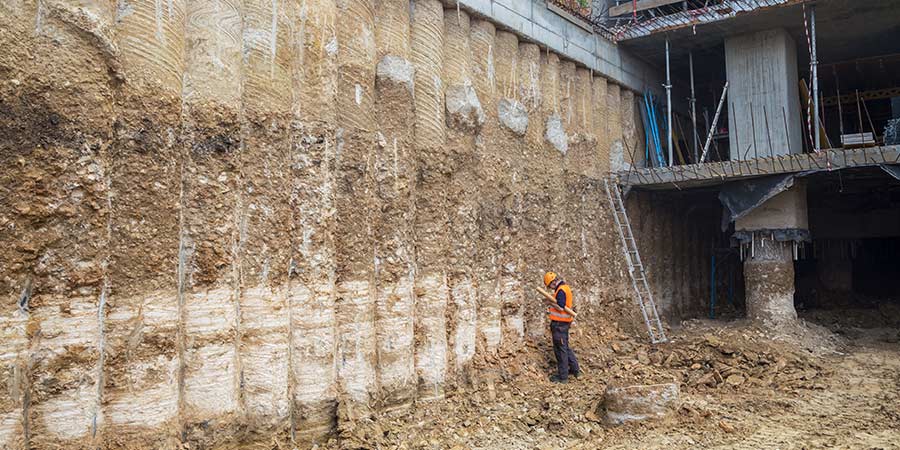
A geotechnical report is an invaluable tool for any commercial building and infrastructure project. This detailed site condition report is essential not only for understanding the mechanical properties of the site but for assessing the risk factors for water infiltration and understanding the soil composition, including whether the soil contains any harmful chemicals or gases. Reviewing the following report elements will help determine waterproofing needs.
Groundwater table.
Understanding the elevation of the groundwater table is critical both from a structural standpoint and for determining what waterproofing is needed. This information should be reviewed in conjunction with the projected rainfall for the region. If the water table will come close to the slab elevation, evaluate how quickly rainwater is expected to dissipate through the type of soil at the site.
Your geotechnical report should also clarify if the water table is constant or fluctuating. If it fluctuates, you’ll need to know how high it will be at its highest point. (Note: Most geotechnical reports will provide a bit of a “cushion” of a few feet when estimating the height of the water table.)
Soil contamination.
Addressing soil and water contamination is a growing concern since so much construction is taking place on reclaimed land. Examine the nature of any contamination at the site. Some common questions to consider include:
- What is the type of contaminant and exposure risk?
- What is the level of contamination?
- How much of the soil has to be removed from the site?
- What type of barrier will keep building tenants safe from exposure to contaminated soil or water?
- How long will this barrier last?
- How do you test to ensure the barrier is protecting properly?
- Is there any maintenance required for the barrier system?
Ground settlement.
This can affect the type of slab support and thickness of the slab. If there is an indication of ground settlement, it would be beneficial to use fully bonded waterproofing system. If ground settlement occurs, a waterproofing system that is not fully bonded is likely to fall away from the slab, putting stress on the waterproofing system. This could lead to tears and fish mouths.
There are additional conditions that can cause ground settling issues. For example, fluctuations in the water table can increase the amount of ground settlement. In addition, having organic matter such as tree roots or rotting wood in the soil can cause settling issues as these materials break down over time.
Soil types.
Rocky and clay-laden soil retains a considerable amount of water, which can create temporary hydrostatic head conditions during heavy rains, even in a "dry excavation". This leads to perched water conditions (i.e., water within the layers of soil or rock at an elevation that is higher than the groundwater table). This means that if the soil is rocky or clay-like, there is still a risk of water intrusion, even if you are not building within the water table. In these instances, installing a quality waterproofing system is necessary.
Learn more about PREPRUFE® Plus waterproofing membrane
Soil retention.
Many geotechnical reports will recommend soil retention systems such as sheeting or piles with timber lagging. Those can affect the choice of waterproofing since the waterproofing membrane will be affixed to this surface. It’s also important to consider how long the retention system will be in place. For ex, timber lagging will deteriorate and steel materials will corrode over time.
Dewatering.
A properly dewatered site is essential for a successful waterproofing installation for any system. Dewatering is typically only part of the solution needed for below grade structures. Your waterproofing expert will need to know whether your dewatering system will be temporary or permanently a part of the structure.
Temporary dewatering during excavation and construction should become a major consideration when building within the water table. In considering the costs of the dewatering system, be sure to account for necessary backup generators, since the cost of a failure could be catastrophic. Maintenance costs of the dewatering system are also important to calculate, since most dewatering systems require regular cleanouts.
Seismic movement.
If the area is prone to seismic activity, this will impact the type of waterproofing used. Typically seismic movements can push water upwards, causing water infiltration problems were they did not exist before.
Related articles
August 29, 2018
Soil Contamination and its Impact on Indoor Air Quality
People can be exposed to soil contaminants in a number of ways, including: Breathing VOCs that intruded into the home or into the outdoor air Absorbing chemicals through their skin when coming in ...
READ MOREApril 03, 2018
Waterproofing mass transit systems
Water and moisture intrusion can cause significant damage to mass transit systems, resulting in high replacement costs, lost revenue, and serious disruption in travel. Underground stations require a d...
READ MOREMarch 28, 2018
Waterproofing structures in extreme climates
Poised at the end of Doha Bay, the Museum of Islamic Art rises from the waters of the Arabian Gulf. The climate and corrosive salt environment of the Persian Gulf created a number of challenges for th...
READ MOREMay 28, 2018
Waterproof concrete: Is it enough for protecting foundations?
Waterproofing protects your structure and the assets within it against damaging moisture, humidity, and floods. Although waterproofing systems account for a small fraction of the cost of an overall bu...
READ MOREMay 14, 2018
Specifying below grade waterproofing
Waterproofing basements and other below grade spaces takes special considerations. Here are five points to consider when specifying waterproofing for these spaces. Investigate the water table l...
READ MORETags
- PREPRUFE PLUS
- Waterproofing